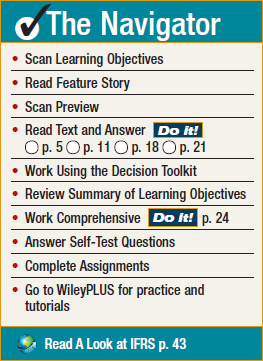CHAPTER 1

INTRODUCTION TO FINANCIAL STATEMENTS

LEARNING OBJECTIVES
After studying this chapter, you should be able to:
- Describe the primary forms of business organization.
- Identify the users and uses of accounting information.
- Explain the three principal types of business activity.
- Describe the content and purpose of each of the financial statements.
- Explain the meaning of assets, liabilities, and stockholders’ equity, and state the basic accounting equation.
- Describe the components that supplement the financial statements in an annual report.
![]()
The Navigator is a learning system designed to prompt you to use the learning aids in the chapter and to set priorities as you study.
Feature Story

KNOWING THE NUMBERS
Many students who take this course do not plan to be accountants. If you are in that group, you might be thinking, “If I'm not going to be an accountant, why do I need to know accounting?” Well, consider this quote from Harold Geneen, the former chairman of IT&T: “To be good at your business, you have to know the numbers—cold.” In business, accounting and financial statements ...
Get Financial Accounting: Tools for Business Decision Making, 7th Edition now with the O’Reilly learning platform.
O’Reilly members experience books, live events, courses curated by job role, and more from O’Reilly and nearly 200 top publishers.

